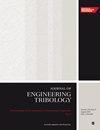Test method for determining the scuffing capacity of oils with reduced oil volume
IF 1.8
3区 工程技术
Q3 ENGINEERING, MECHANICAL
Proceedings of the Institution of Mechanical Engineers, Part J: Journal of Engineering Tribology
Pub Date : 2023-05-10
DOI:10.1177/13506501231172637
引用次数: 1
Abstract
Previous studies by several researchers have shown that the aging of the transmission fluid in dual clutch transmissions has a major impact on the wear protection of the highly loaded tribological contacts. Depending on the transmission design, oil sump temperature, transmitted torque, rotational speed and oil volume, the scuffing ability decreases significantly. Since typically only limited quantities of oil from gearbox tests are available to evaluate oil condition with respect to wear protection properties, available analytical standards are currently limited to methods such as viscometry, TAN, elemental analysis, and IR. A test method is presented that can be used to determine the gear scuffing load capacity of transmission fluids with a reduced oil volume. For this purpose, a standard test rig is modified to reduce the test oil volume from 1.25 liters, as specified in the public standards, to 0.5 liters. The applicability of the reduced test oil volume is demonstrated and the remaining scuffing wear protection of several used oil samples from durability testing is presented. A comparison of the tribological results with the chemical oil analysis results shows the advantage of direct testing of the oil's service properties.测定油体积减小的油的耐磨损能力的试验方法
几位研究人员先前的研究表明,在双离合器变速器中,传动液的老化对高负荷摩擦接触的磨损保护有重大影响。根据变速器设计、油底壳温度、传递扭矩、转速和油量的不同,磨损能力会显著降低。由于通常只能从齿轮箱试验中获得有限数量的油来评估油的磨损保护性能,因此可用的分析标准目前仅限于粘度法、TAN、元素分析和IR等方法。提出了一种可用于确定减少油量的传动液的齿轮磨损负荷能力的试验方法。为此,对标准测试台进行了修改,以将公共标准规定的1.25升测试油量减少到0.5升。论证了减小试验油量的适用性,并介绍了几种耐久性试验废油样的剩余磨损保护。摩擦学结果与化学油分析结果的比较表明,直接测试油品的使用性能具有优势。
本文章由计算机程序翻译,如有差异,请以英文原文为准。
求助全文
约1分钟内获得全文
求助全文
来源期刊

CiteScore
4.20
自引率
5.00%
发文量
110
审稿时长
6.1 months
期刊介绍:
The Journal of Engineering Tribology publishes high-quality, peer-reviewed papers from academia and industry worldwide on the engineering science associated with tribology and its applications.
"I am proud to say that I have been part of the tribology research community for almost 20 years. That community has always seemed to me to be highly active, progressive, and closely knit. The conferences are well attended and are characterised by a warmth and friendliness that transcends national boundaries. I see Part J as being an important part of that community, giving us an outlet to publish and promote our scholarly activities. I very much look forward to my term of office as editor of your Journal. I hope you will continue to submit papers, help out with reviewing, and most importantly to read and talk about the work you will find there." Professor Rob Dwyer-Joyce, Sheffield University, UK
This journal is a member of the Committee on Publication Ethics (COPE).
 求助内容:
求助内容: 应助结果提醒方式:
应助结果提醒方式:


